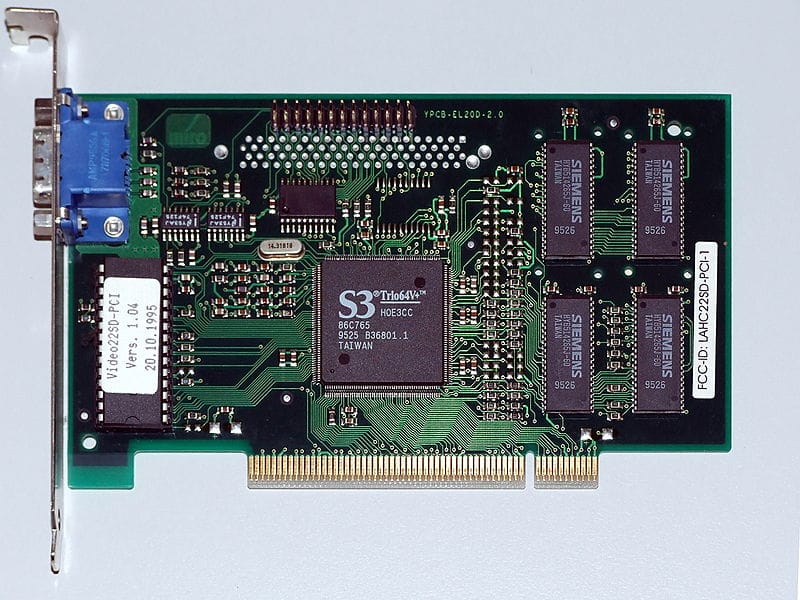Review S3 Graphics DeltaChrome S4 Pro Gaming: Drivers | Windows 7/10/11| MHz – Despite numerous announcements for the DeltaChrome family of GPUs, S3 Graphics continues to be largely oblivious to the desktop graphics market. Searching for offers in the United States using the search engines www.pricewatch.com , xbitlabs.dealtime.com and www.pricegrabber.com did not return any results – we did not find any offers related to DeltaChrome.
Moreover, this GPU was simply missing from the search lists. The situation is somewhat better in Europe and Asia – here products based on S3 Graphics can be purchased, however, this is fraught with a number of difficulties.
It seems that the company is not interested in promoting its products to store shelves. In fact, this rather categorical statement is only partially true – do not forget that penetration into the desktop graphics market is currently associated with huge difficulties and costs that are unlikely to pay off in the short term, and therefore the S3 Graphics initiative, at least is commendable.
In addition to retail sales at the heart of video cards, the DeltaChrome series chips have another, no less interesting prospect – to become a part of integrated system logic sets, because S3 Graphics is the property of one of the largest chipset manufacturers – VIA Technologies. The new graphics core is exactly the component that VIA’s integrated chipsets need most now.
At the moment, they use the outdated UniChrome core, which descends from the S3 Savage4 / 2000, which looks completely uncompetitive against the background of such solutions as Intel Graphics Media Accelerator 900, ATI RADEON 9100/9100 PRO IGP and NVIDIA nForce2 IGP. Therefore, it is obvious that the introduction of a new graphics core into the integrated chipsets of VIA is a long overdue necessity.
Our today’s review is dedicated to another representative of the S3 DeltaChrome line – the DeltaChrome S4 Pro graphics processor, one of the variants of which, apparently, will take the place of UniChrome in future integrated chipsets from VIA Technologies. Architecturally, the DeltaChrome S4 Pro is similar in everything to its older brothers – the DeltaChrome S8 and S8 Nitro processors, with the exception of clock frequencies and the number of pixel and vertex pipelines – on the S4 Pro it is halved.
Of course, the DeltaChrome S4 Pro arrived at our laboratory in the form of a regular AGP card, but this does not hurt to evaluate its prospects both as a separate video adapter and as an integrated video core.
It makes no sense to talk again about the DeltaChrome architecture, since it has already been described in detail in the reviews devoted toDeltaChrome S8 and DeltaChrome S8 Nitro . A short list of GPU capabilities looks like this:
Supports Pixel Shaders 2.0+
Supports Vertex Shaders 2.0+
4 Pixel Pipes
2 Vertex Pipes
Supports 400 MHz RAMDAC Multi- Monitor Configurations Built-in TV-Out Controller Built- in TMDS Transmitter Support for Component Video Output (YPbPr, 480p / 720p / 1080i / 1080p modes) Programmable Chromotion video stream processing engine AGP 8x support
Theoretically, DeltaChrome S4 Pro is in no way inferior to its potential competitors – ATI RADEON 9600 and NVIDIA GeForce FX 5600/5700, but we still have to check whether this is so in practice.
In previous reviews, the S3 DeltaChrome S8 and S8 Nitro, despite having 8 pipelines, were inferior in a number of tests to the four-pipe RADEON 9600 XT and GeForce FX 5700 Ultra – this was due to both the relatively low efficiency of the DeltaChrome architecture and the low quality of driver optimization. This time we will try to find out what level of gaming performance the new entry-level solution from S3 Graphics, the DeltaChrome S4 Pro, can provide, and whether the situation with the quality of drivers has improved – this issue has a rich history for S3 Graphics.
S3 Graphics DeltaChrome S4 Pro
The novelty arrived at our test laboratory in an aristocratic black box with the inscription “S3 Graphics” – just like the S8 Nitro in its time.
In addition to the card in the box, we found a splitter designed to connect HDTV-compatible devices equipped with a component video input, as well as a CD with drivers, documentation, and a patch for the Halo game. Unlike the S8 / S8 Nitro, which were the subjects of previous reviews, the S4 Pro, at first glance, looks like a completely finished product, ready to hit the shelves of retail stores right now.
This impression is created by the absence of any trimming resistors, temporary elements and empty spaces on the PCB. A small, neat cooler, similar to those installed on some RADEON 9600 PRO models, is embedded in a layer of high-quality thermal paste. For a four-pipeline solution, a passive radiator would be enough, especially since one of the main advantages of DeltaChrome processors is their efficiency,
Unlike its older brothers, DeltaChrome S4 Pro is equipped with memory in TSOP packaging, which is not typical for a modern solution. However, video memory on boards of this class usually operates at relatively low frequencies, so the use of inexpensive chips in TSOP packages is quite justified. In our case, the memory chip has a cycle time of 3.3 nanoseconds, and the nominal clock frequency of the video memory is 600 (300 DDR) MHz. The GPU is also clocked at 300 MHz.
The memory chips do not have their own cooling system, but they do not need it – even with intensive work, the memory heats up very slightly, as well as the graphics processor – during testing it remained only slightly warm.
On the back of the PCB you can see curious stripes reminiscent of ABIT Overclocking Strips. In the case of ABIT motherboards, such strips are designed to improve stability by improving heat dissipation from key transistors and reducing resistance in the power supply circuits of the central processor. However, we cannot say that they play the same role here, since in terms of power consumption and heat dissipation, the DeltaChrome S4 cannot be compared with powerful central processors. Most likely, on the S4 Pro, these stripes have a purely aesthetic purpose.
Test system and test conditions
It’s time to finally test the capabilities of today’s guest of our laboratory and find out what the S3 DeltaChrome S4 Pro video adapter is capable of in real conditions. The following video cards have become the rivals of the S4 Pro:
ATI RADEON 9600
ATI RADEON 9200
NVIDIA GeForce FX 5700
NVIDIA GeForce FX 5600
For comparison, the test participants also included S3 DeltaChrome S8 and S3 DeltaChrome S8 Nitro cards. The tests were carried out on a platform with the following configuration:
AMD Athlon 64 3400+ CPU (2.20GHz, 1MB L1 cache);
ASUS K8V Deluxe mainboard;
OCZ PC-3200 Platinum EB DDR SDRAM (2x512MB, CL2.5-3-2-8);
Seagate 7200.7 HDD (SerialATA-150, 8MB buffer);
Creative SoundBlaster Audigy 2;
Microsoft Windows XP Pro SP2, DirectX 9.0c;
The list of tests includes games that more or less intensively use the capabilities of modern graphics processors:
Call of Duty
RTCW: Enemy Territory
Unreal Tournament 2004
Halo
Painkiller
FarCry
Splinter Cell: Pandora Tomorrow
Prince of Persia: Sands of Time
Max Payne 2: The Fall of Max Payne
IL-2 Sturmovik: Aces
Colin McRae Rally 04
Command & Conquer Generals: Zero Hour
Due to the fact that modern games, as a rule, are very demanding on the resources of video cards, and S3 Graphics DeltaChrome S4 is an entry-level solution, we refused to use a resolution of 1600×1200, since the speed of modern games on entry-level cards in this mode most often cannot be called comfortable.
Modes using anisotropic filtering and full-screen anti-aliasing were also excluded from testing, since the new drivers from S3 Graphics still do not include support for multisampling, and the only 2x supersampling mode available for DeltaChrome turns out to be more resource-intensive and of lower quality than 4x multisampling on modern video cards.
So let’s get started.
Game tests: Call of Duty
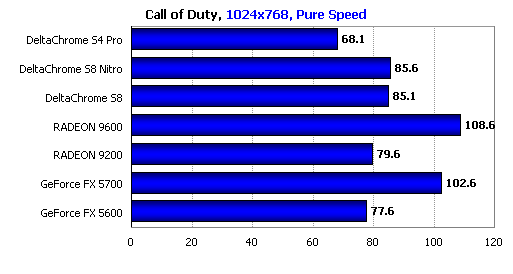
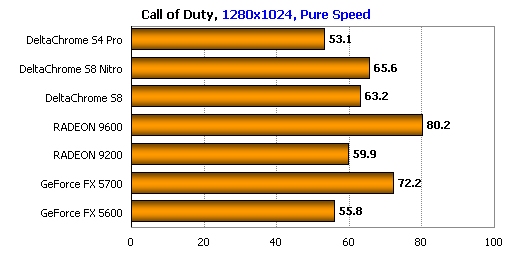
In the very first game, where simple pixel shaders are used to draw the water surface, DeltaChrome S4 Pro lagged behind everyone – the number of vertex processors and pixel pipelines cut in half compared to the DeltaChrome S8 / S8 Nitro had an effect. Not a very encouraging result, despite the fact that the graphics in this shooter are not that heavy.
Two cards stand out here: the RADEON 9600, which has a high efficiency of shader execution, and the GeForce FX 5700, due to the high frequencies and high performance of the geometry processing unit.
Game tests: RTCW: Enemy Territory
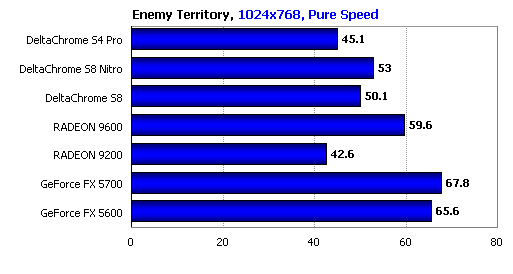
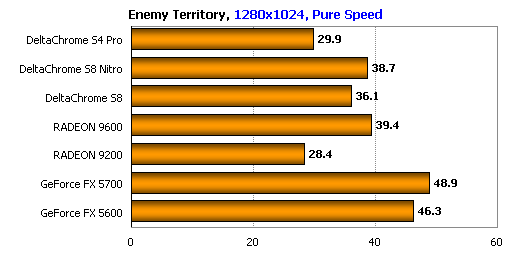
RTCW: Enemy Territory doesn’t use pixel shaders at all. The cards with the highest filling rate, efficient work with video memory and efficient geometry processing units have the advantage here. The quality of the OpenGL driver naturally also affects the result. Due to all these circumstances, video cards based on NVIDIA chips demonstrate the best results, while our hero has to be content with the outdated RADEON 9200. It should be noted that the DeltaChrome S4 Pro lags behind S8 / S8 Nitro not as great as one might expect.
Game tests: Unreal Tournament 2004
As always, in this game, we used two demo recordings, one of which provides as strong a texture load as possible, and the other one geometrically.
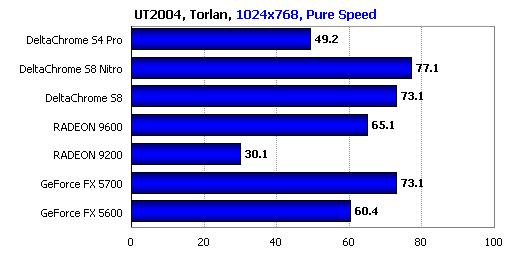
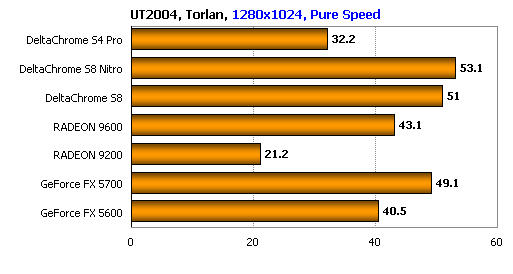
Open spaces, a distant horizon, huge textures and a lot of objects – people, buildings, cars … DeltaChrome S4 Pro copes with such a load poorly, and the gap between it and older models from S3Graphics is widening. Video cards based on S8 / S8Nitro, meanwhile, hold up excellently, outperforming all rivals, thanks to the presence of eight pixel pipelines versus four on the other cards. In addition, the older DeltaChrome models have relatively fast video memory, which also has a positive effect on the results.
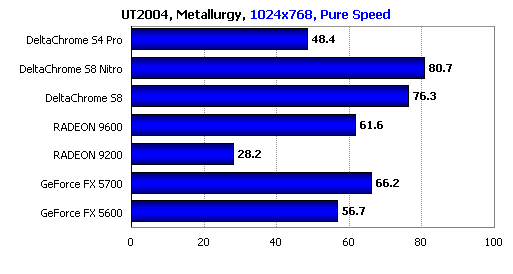
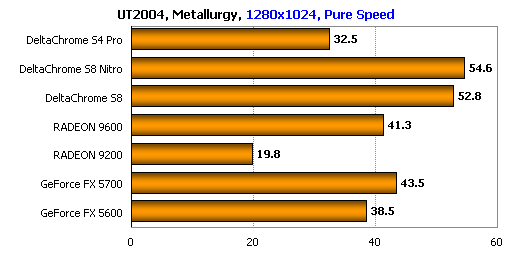
In the Metallurgy scene, eight pipelines once again help the DeltaChrome S8 and S8 Nitro cards outperform the competition. It is also likely that with the release of the new driver version, the company’s programmers managed to optimize the operation of the DeltaChrome vertex processors, since in this test scene with a large number of polygons, the S8 and S8 Nitro feel great.
As for the DeltaChrome S4 Pro, everything is bad again – the diagrams speak volumes about this – the relatively low efficiency of pixel pipelines and the presence of only 2 vertex processors led to a natural result.
Game tests: Halo
The results of the RADEON 9200 are not given – it does not have hardware support for shaders 2.0.
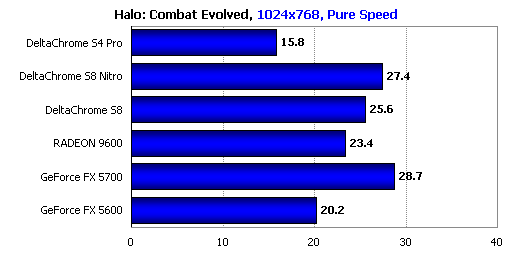
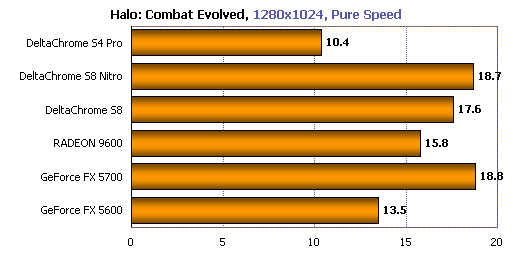
The older models from S3 show quite competitive results, but do not forget that they have twice as many pixel pipelines as compared to the RADEON 9600 and GeForce FX 5700/5600.
For DeltaChrome S4 Pro, which has the same 4 pixel pipelines as competitors from ATI and NVIDIA, this is a complete failure – even the minimum acceptable performance is not provided. It seems that modern complex games are too tough for our hero with its low efficiency of pixel pipelines and relatively low clock frequency. Let’s see how he behaves further.
Game Tests: Painkiller
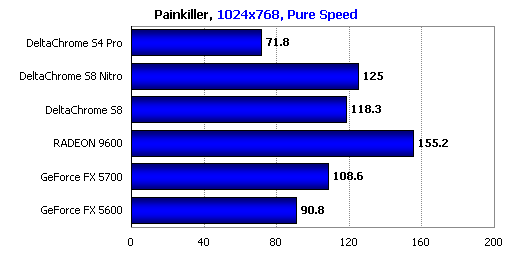
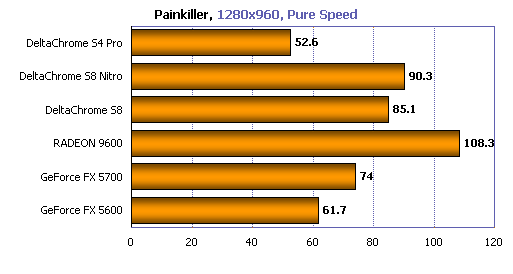
Good news: DeltaChrome S4 Pro provides good playability in Painkiller. But the merit here belongs not to S3Graphics, but to the programmers of the People Can Fly team, who managed to create such an effective, undemanding, but, at the same time, beautiful engine.
DeltaChrome S4 Pro lags behind the older DeltaChrome models by almost two times, which is not surprising, given the presence of only 4 pixel pipelines and 2 vertex processors against, respectively, eight and four in older models.
Game tests: FarCry
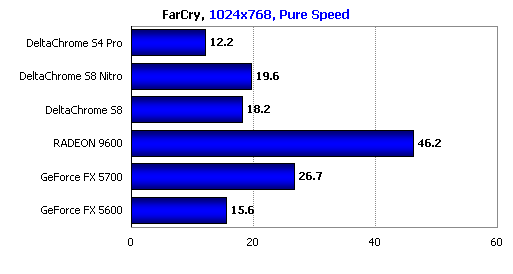
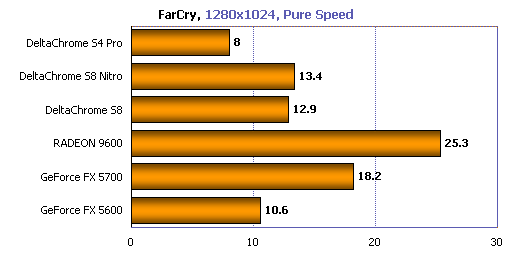
The spectacle is not for the faint of heart – on all cards, except for the RADEON 9600, FarCry has turned from a great game into a great … slide show. However, this game easily brings to its knees and much more powerful cards than the entry-level solutions.
The low efficiency of DeltaChrome pixel pipelines in Far Cry is most evident: the 8-pipe S8 / S8 Nitro lags behind the 4-pipe RADEON 9600 2-3 times, and the four-pipe S4 – 3-4 times.
Game tests: Splinter Cell: Pandora Tomorrow
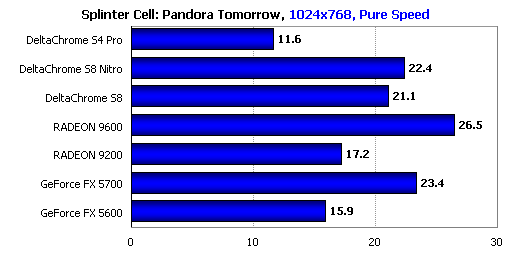
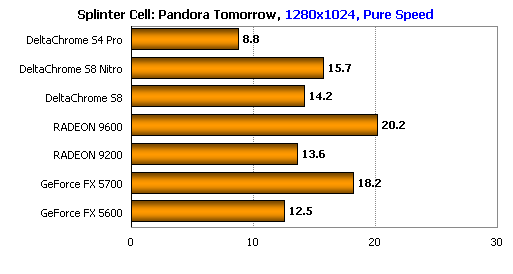
Pixel shaders are widely used in this game, and this affects the results – the RADEON 9600 wins here, which has the highest pixel shader performance. The DeltaChrome family looks far from the best here – only 8 pixel pipelines help the older models save face, while the younger model loses even to the GeForce FX 5600.
Game tests: Prince of Persia: Sands of Time
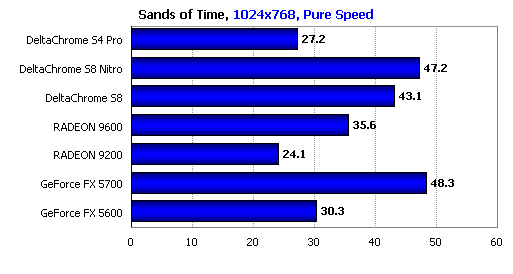
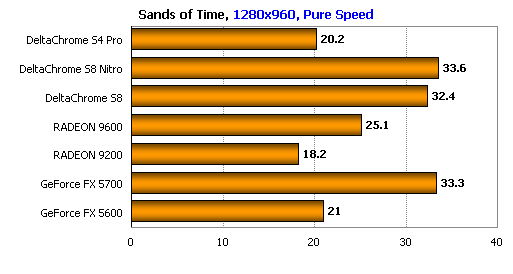
There are many shader effects here, but they are not as complex as, say, in FarCry. The GeForce FX 5700 feels best in this game, which is helped by fast vertex processors, high frequency and an optimizing shader compiler built into the ForceWare driver. The older DeltaChrome models look almost as good. However, the “cut-down” DeltaChrome S4 Pro, alas, can only compete with the GeForce FX 5600 and RADEON 9200.
Game tests: Max Payne 2: The Fall of Max Payne
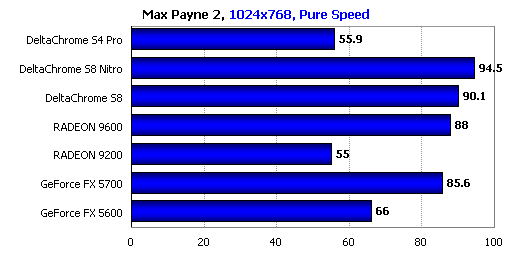
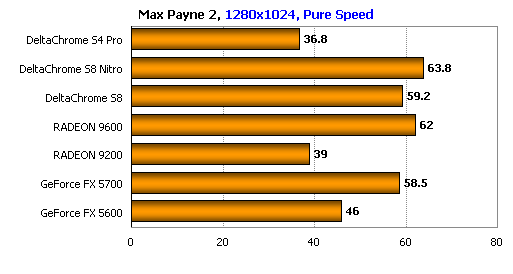
The DeltaChrome S8 Nitro became the winner in this game, outperforming the RADEON 9600 by a small margin! However, it is worth recalling again that the RADEON 9600 has only four pixel pipelines, while the S8 Nitro has 8. The four-pipe DeltaChrome S4 Pro can only compete with the RADEON 9200.
Game tests: IL-2 Sturmovik: Aces
Here, when displaying a water surface, pixel shaders 2.0 are used, so the results of the RADEON 9200 are not shown.
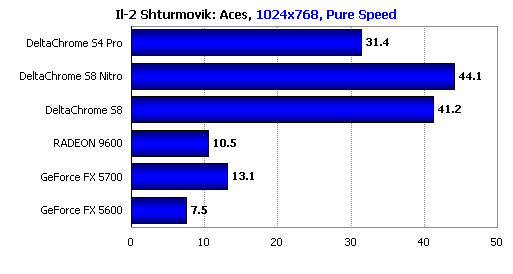
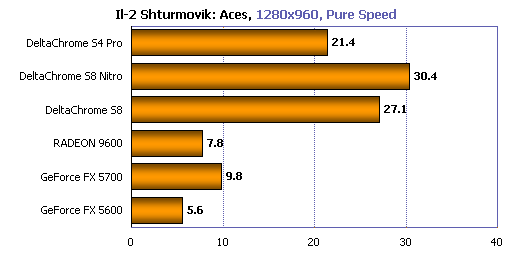
The performance of the S3 DeltaChrome S8 here practically matches the performance of the GeForce 6800 Ultra, a video adapter that cannot be compared with the entry-level solutions either in price or in capabilities – interesting, isn’t it?
The very first glance at the screen revealed the reason for the appearance of such unusual results for boards from S3 Graphics. The Sturmovik graphics engine did not find support for shaders on boards from S3 Graphics and, accordingly, did not allow using the “excellent” terrain detail mode. This means that, firstly, video cards based on DeltaChrome displayed less detailed landscape with the horizon moved closer to the player, and secondly, they did not use pixel shaders when drawing the water surface and coastline.
All this is clearly seen in the screenshots: on the left – the images obtained on the DeltaChrome S4 Pro, and on the right – on the RADEON 9600: As you can see in the screenshots, the less detailed landscape and the absence of shaders are not limited to: ordinary clouds in this scene on DeltaChrome look like thunderstorm. The problem is obviously in the drivers from S3, which, as practice shows, are still far from perfect.
Game Tests: Colin McRae Rally 04
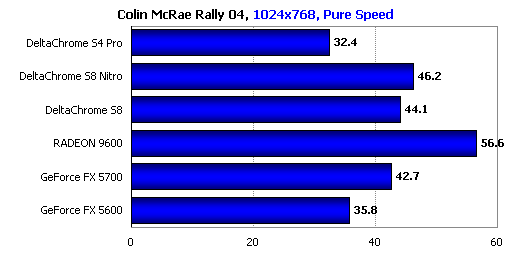
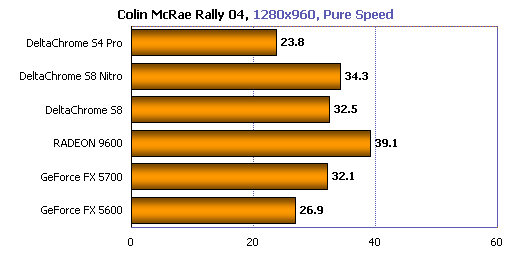
Colin McRae Rally 04 is a technically quite advanced car simulator that uses DirectX 9 capabilities.
Unfortunately, the game did not go beyond the splash screen on the RADEON 9200.
As for the rest, the results turned out to be quite predictable – the RADEON 9600 came out on top, which executes pixel shaders most efficiently. The S3 DeltaChrome S4 Nitro, with the number of pixel and vertex units cut in half compared to the S8 / S8 Nitro, was inferior to everyone.
Game tests: Command & Conquer Generals: Zero Hour
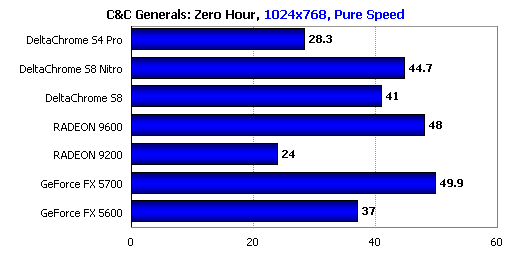
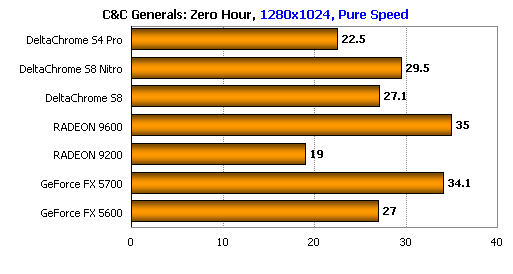
Complex pixel shaders DirectX 9 are not used here – the game puts forward requirements, first of all, to texturing speed, memory subsystem efficiency and vertex processor performance.
The S8 / S8Nitro are inferior to the four-pipe RADEON 9600 and GeForce FX 5700, but the DeltaChrome S4 is not that far behind the older models – it has a half-speed graphics processor, but the same as in the older models, a full-fledged 128-bit memory bus.
Video playback: DivX, DVD, HDTV
MPEG-4, DVD and HDTV
Playability The new graphics processor from S3Graphics, DeltaChrome S4 Pro, we tested for video playback in various formats: HDTV, MPEG-4 / DivX and MPEG-2 / DVD. In all three cases we used Windows Media Player 9. To test the Chromotion functionality, we used InterVideo WinDVD 5, specially optimized for use with DeltaChrome cards.
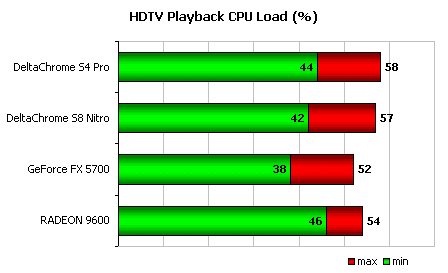
The resolution of the video being played with a bitrate of 8 Mbit was 1920 x 1080. While playing it, no surprises were revealed – all the cards showed approximately the same level of the system’s central processor load. This is not surprising, considering that the lion’s share of resources during HDTV playback is spent on unpacking the video stream using the central processor, and video cards only display the final result.
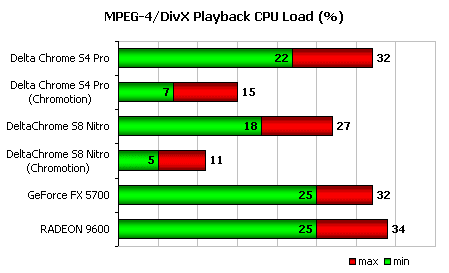
When playing a file with a resolution of 640×480, encoded with the DivX codec, it turned out that there really is some benefit from optimizations for the S3 Chromotion engine. The processor load, which is already small, with the use of Chromotion – using a special version of WinDVD that includes support for Cromotion – has more than halved. The diagram shows that the DeltaChrome S4 Pro is slightly behind the DeltaChrome S8 Nitro in terms of processor load, but the difference between them is quite small.
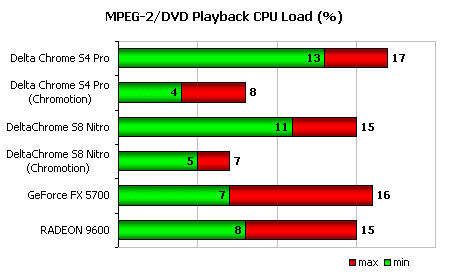
The DVD playback test did not cause any problems. All cards showed approximately the same results, and enabling Chromotion on DeltaChrome again helped to reduce the CPU load by more than half.
So, in general, the S3 DeltaChrome S4 Pro copes with playing video files of different formats as well as the older DeltaChrome model – S8 Nitro. The Chromotion engine delivers great results when playing DivX videos and DVDs. If these optimizations are not used, the video card provides approximately the same processor load as its competitors from ATI and NVIDIA.
Conclusion
S3 Graphics is currently actively working with several graphics card partners, a company spokesman told us. Among them were mentioned such manufacturers as Club3D and IO Data, which are already supplying video cards based on the DeltaChrome S8 chip to the market. In addition to European suppliers, S3 Graphics is in talks with a number of companies operating in the North American market, but their names have not yet been disclosed.
The possibility of using DeltaChrome in game consoles and mobile PCs is also being considered – this is not surprising, given the low level of power consumption and heat dissipation of graphics processors from S3Graphics.
We have not received any official information regarding the possibility of using DeltaChrome S4 Pro as a new graphics core for integrated VIA chipsets, so for now we can only guess which core will actually be used in future integrated chipsets from VIA. S3 Graphics is also thinking about invading the corporate market, but this statement can only be viewed with skepticism. This market segment is extremely conservative. Most office PCs use integrated graphics from Intel, which perfectly meet the requirements for such systems, and are equipped with the most stable drivers, which, unfortunately, cannot yet be said about the S3 drivers.
Despite the relatively low performance in gaming tests, the new S3 DeltaChrome S4 Pro graphics processor, paradoxically as it sounds, performed well.
The point is that S3 Graphics positions it not as a rival to the RADEON 9600 and GeForce FX 5700, but as a rival to the GeForce FX 5200 Ultra and RADEON 9600 SE.
Unfortunately, at the time of testing, our arsenal did not have the necessary cards to check how S3 Graphics’ statement corresponds to the true state of affairs. Nevertheless, we believe that the DeltaChrome S4 Pro should cope with this mission without any problems, since the performance of the GeForce FX 5200 Ultra is much lower than that of the GeForce FX 5700 and even the FX 5600. In turn, the RADEON 9600 SE is seriously limited. 64-bit memory bus, whereas DeltaChrome S4 Pro is equipped with a full-fledged 128-bit memory subsystem operating at 300 (600) MHz.
As for other technical characteristics, the DeltaChrome S4 Pro is also at its best – it has support for pixel and vertex shaders version 2.0+, as well as a number of interesting features that make it an excellent choice for use in inexpensive home multimedia systems.
These include, in particular, the “innate” support for the HDTV standard and the advanced capabilities for decoding video streams provided by the Chromotion engine. Thus, the DeltaChrome S4 Pro is perfect for low-cost gaming machines as well as so-called home media PCs. If cards based on this GPU do appear in large quantities on store shelves, and at the same time their cost will be comparable to the cost of GeForce FX 5200 and RADEON 9600 SE,





